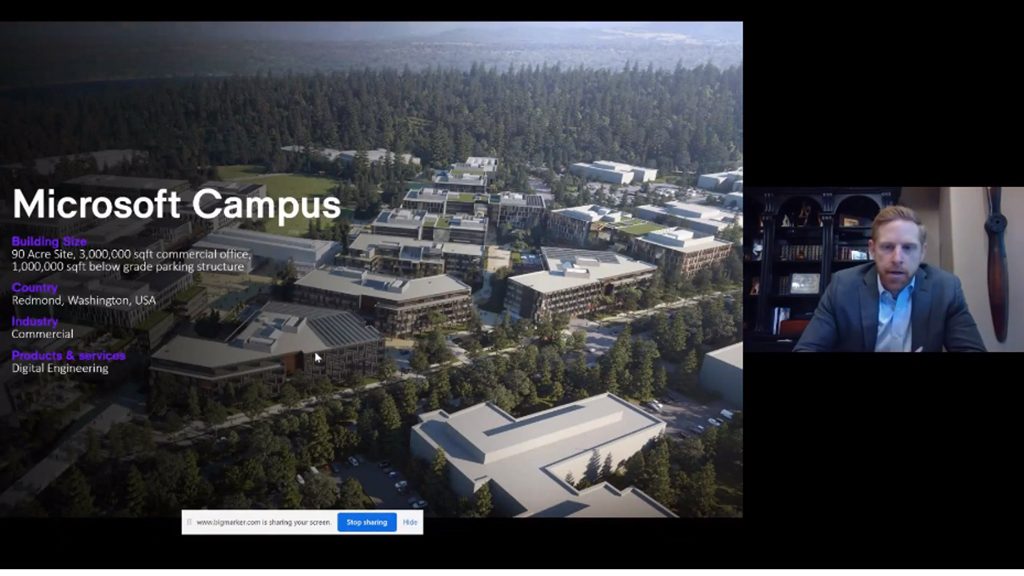A global tech company is connecting digital twinning with complicated projects and expansive property portfolios.
Willow president and global head of real estate Shaun Klann spoke to virtual attendees at CanBIM’s recent online conference focusing on the digital twin concept, where real world buildings are replicated and updated in digital form.
Willow began with “10 years as a digital design and construction company, which started becoming an early adopter of BIM, virtual reality and augmented reality,” Klann said.
“We found at the end of the day a lot of digital artifacts were being created, but they ended up scattered and underutilized in the operational phase of the asset.
“We need to get information into a context we can do something with. Every day, owners are losing untold amounts of value through lost data. We’re still handing over buildings with different media types such as Excel files, USB sticks, CD-ROMs and paper binders,” Klann said.
The answer is to create a digital repository that has a use in the construction industry.
Digital twinning was pioneered by NASA when it would replicate missions in space with modelling on the ground.
It has morphed into the aerospace, manufacturing and health care industries, Klann said, “and where we are today is the tip of the spear.
“A digital twin is a digital replica of a physical asset. It organizes all the information that comes through at an early stage of construction, integrates it and optimizes it,” he said.
Klann said digital twins are now being used not just for individual buildings but to keep track of data in an entire property portfolio.
“An existing problem is how to integrate five, 10, 15 or 20-year-old buildings. We’re all looking at ways to drive technological innovation across the broader portfolio and geographical area in order to (let companies) see how they’re investments are doing,” he said.
The Canadian market is particularly receptive to adopting digital technology to manage investments, he said.
“The Canadian market is more innovative. It’s a natural home for pension funds and REITs. A lot of them have a forward-thinking attitude on digitalization and looking to disrupt the status quo a bit,” Klann said.
Data gathered during construction can also prove useful throughout the lifecycle of a building or buildings, he added.
“Information is useful during the process, but wouldn’t it be useful 10 years later or in the case of seismic data, before and after an earthquake?” he asked.
Willow builds its own software on top of Microsoft’s Azure code, Klann said, which enables tracking of digital assets through the supply chain.
“Digital Twin Definition Language is an initiative between Willow and Microsoft to map relational elements of these devices, whether it’s a spatial, system or asset relationship,” he said.
“That’s the next evolution of this, going back into the supply chain to get more use out of this relationship.”
In addition to collaborating at a code level, Willow and Microsoft are working together on a $5 billion bricks and mortar project on the Microsoft campus in Seattle.
“Microsoft is currently going through a major modernization where they’re tearing down 12 buildings and coming back out of the ground with 18 new buildings,” he said. “When they embarked on this new renovation project, they said it was a once-in-a-lifetime opportunity to structure everything right so we can deliver to ourselves a perpetual learning lab with all the information associated with our buildings.”
In addition to technology companies, commercial buildings, airports, sports and entertainment complexes and even railways are implementing digital twinning, Klann said.
“It takes the same approach, but applies it to horizontal infrastructure rather than vertical,” he said.
Sports venues can also use digital twinning for “just in time” reconfigurations, he added.
“SoFi Stadium (in Inglewood, Calif.) needs to quickly reconfigure how it operates on a day-to-day basis. Pre-game day on Sunday, they would start readiness checks on Thursday with items such as signage and lights. With a digital twin (approach), they can do so with scripts that go through automated testing scenarios,” Klann said.











Recent Comments
comments for this post are closed